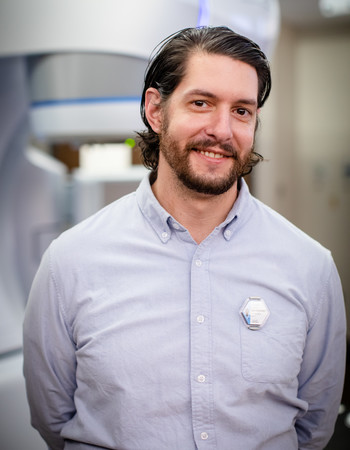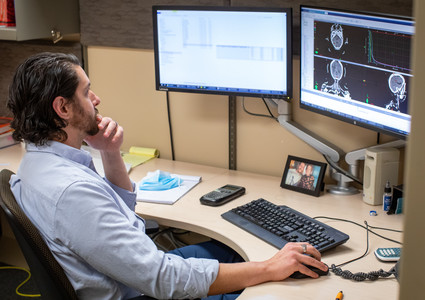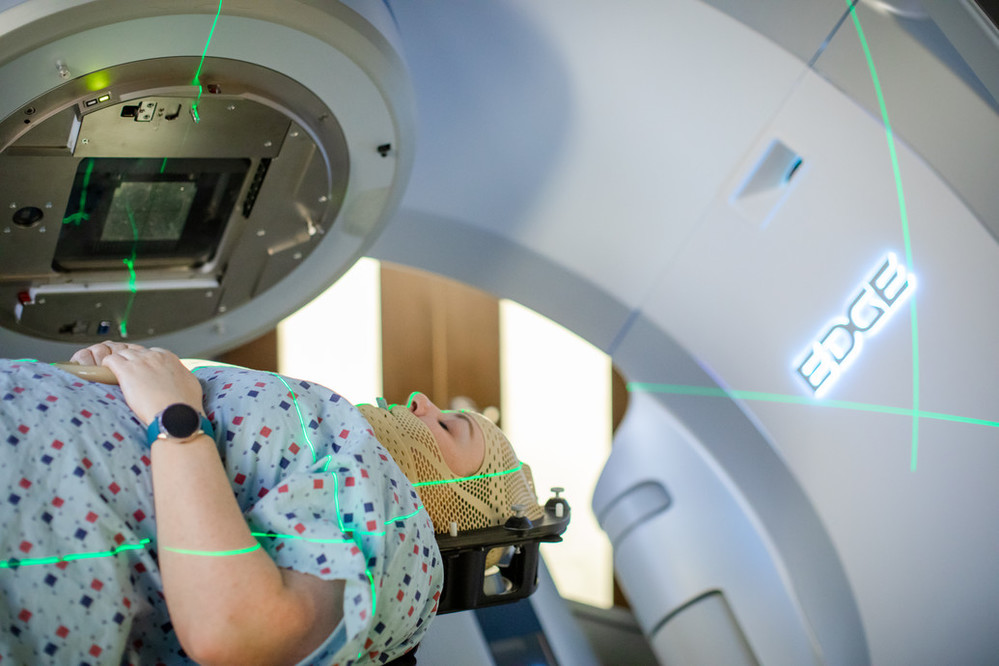





The Meaning of Care Magazine
Radiating Comfort and Hope With a New Wave of Technology
Published: March 16, 2022He made a mistake.
“A very human error,” said Methodist radiation physicist Spenser Murphy, MS, DABR, referencing his most humbling moment.

It came years ago, when he was a student in training at the University of Kentucky: “I basically missed an error in the most important safety aspect of a radiation plan.”
And it could have resulted in a cancer patient receiving radiation to the wrong part of their body.
“The program mentor sat me down and reiterated my charge of duty. That charge of, ‘You have to treat every patient like it’s your mom – one of your family members.’ Since then, I’ve always maintained that reality. Because that’s what it is – reality. That is someone’s mom. That is someone’s family member.”
No Room for Error
Murphy and his colleagues at Methodist Estabrook Cancer Center (MECC) agree: There’s no room for error in radiation oncology.
Creating treatment plans requires an immeasurable level of precision, skill, expertise and critical thinking – things that come a bit easier when you’re accustomed to treating patients like family.
“Having cancer is scary,” said Tien-Shew (Bill) Huang, MD, a radiation oncologist at MECC. “Patients are afraid of suffering and death, and there are so many unknowns. Our job is to, yes, give them a very clear understanding of their disease process and the recommended treatment approach, but also provide them comfort and hope.”

And thanks to state-of-the-art technology, patients at MECC – which became home to the region’s first HyperArc™ radiation delivery system in November – can expect so much more than comfort and hope. According to Dr. Huang, they can expect “almost miraculous” outcomes.
Precise Planning
MECC’s HyperArc system is a software upgrade designed specifically for patients with brain metastases – or multiple brain tumors. At Methodist, it’s used in conjunction with the Varian Edge™ stereotactic radiosurgery (SRS) machine, which provides continuous radiotherapy to these patients as it rotates around them and the table they’re lying on. Their head is immobilized in a hard-shell mask to ensure that the radiation beams hit the appropriate brain targets – or tumors.
The perks of the automated HyperArc system start at the planning stage. Physicists no longer have to start from scratch when creating a plan for each patient, which eliminates some of the greatest opportunities for errors.

Once cranial images from a computed tomography (CT) scan and magnetic resonance imaging (MRI) scan are uploaded and layered on top of each other to provide a clear view of the patient’s brain anatomy, HyperArc essentially does the initial planning for the physicists while still allowing them the freedom to tweak and perfect each plan.
“It gives us a really good starting point,” Murphy said. “And for the patient, this means higher-quality treatments every time, as it also allows us to deliver a really precise, lethal dose of radiation to each tumor while delivering almost nothing to the rest of the brain.”
Increased Comfort and Convenience
Planning isn’t the only automated feature included with HyperArc – table movement is another. Treatment once required radiation therapists – the experts in charge of administering radiation – to manually move the table so that the machine could safely rotate around the patient. Now, HyperArc does all the tilting and shifting.
Said Murphy: “This gets rid of having to open this giant door, which takes 30 seconds; reverify the position of the patient and make sure they’re in the right spot, which takes another 30 seconds; close the door – another 30 seconds; and reinitiate treatment, which takes about 15 seconds. It sounds like a small thing. But one of our best modes of immobilization is time.”
“The time savings makes treatment more precise,” Dr. Huang said. “Because the longer a patient is on that table, the more time they have to move, squirm and shift. But more than anything, we want to make treatment as comfortable as it can be. Nobody wants to be on that hard, flat table any longer than necessary. It’s all about improving the patient experience, so if they need radiation again, they won’t be anxious about it. They’ll likely return for future treatment.”

“Almost Miraculous”
Although metastatic brain cancer generally comes with a poor prognosis, Dr. Huang remains optimistic. Over the years, he’s witnessed Methodist patient outcomes dramatically improve with best-in-class technology and highly individualized care by a multidisciplinary team of experts.
“Patients with brain metastases can absolutely have long-term survival,” he said. “If left untreated, survival is about two months. But with the help of SRS treatment, I’ve seen these types of patients survive more than 10 years. And that’s almost miraculous.”
Because HyperArc is the newest, most effective radiotherapy approach available for intracranial tumors, patients can rest assured that they’re receiving treatment that’s on par with the most reputable health systems across the country. And because of the compassion, experience and dedication of their care team, they’ll also feel like family.
“Every new patient I get, I’m keeping that experience in the front of my head and the idea that this is someone’s family member,” Murphy said. “What kind of plan would I give my brother or father? Because when it comes to my brother or father, I’ll tell you: Human error is simply unacceptable.”
HyperArc was funded by Methodist Hospital Foundation donors and Leap-For-A-Cure. Founded by the family of Heather Roberts – who lost her battle with brain cancer in 2016 – Leap-For-A-Cure aims to advance brain cancer awareness, education, and diagnostic/treatment options for patients battling brain cancer or severe brain trauma and their families.
More Resources
- Read more from the spring 2022 issue of The Meaning of Care Magazine.
- Learn more about radiation oncology at Methodist.
- Read more stories related to cancer care at Methodist.


